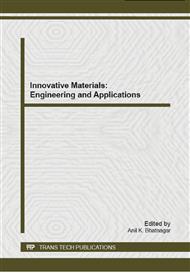[1]
X.J. Wang, X.P. Dong, C.H. Jiang, Thermal performance of sputtered Cu films containing insoluble Zr and Cr for advanced barrierless Cu metallization, Trans. Nonferrous Met. Soc. China. 20 (2010) 217-222.
DOI: 10.1016/s1003-6326(09)60124-2
Google Scholar
[2]
M. Y. Kwak, D. H. Shin, T. W. Kang, et al, Characteristics of TiN barrier layer against Cu diffusion, Thin Solid Films. 339 (1999) 290-293.
DOI: 10.1016/s0040-6090(98)01074-8
Google Scholar
[3]
C. H Lin, J.P. Chu, T. Mahalingam, et al, Sputtered copper films with insoluble Mo for Cu metallization: A thermal annealing study, J. Electron. Mater. 32 (2003) 1235-1239.
DOI: 10.1007/s11664-003-0017-2
Google Scholar
[4]
J.P. Chu, C.H. Lin, Thermal stability of Cu (W) and Cu (Mo) films for advanced barrierless Cu metallization: Effects of annealing time, J. Electron. Mater. 35 (2006) 1933-(1936).
DOI: 10.1007/s11664-006-0296-5
Google Scholar
[5]
Y.K. Ko, J.H. Jang, S. Lee, et al, Effects of molybdenum, silver dopants and a titanium substrate layer on copper film metallization, Journal of Materials Science. 38 (2003) 217-222.
Google Scholar
[6]
P. Djemia, F. Ganot, P. Moch, et al, Brillouin scattering investigation of elastic properties of Cu-Mo solid solution thin films, J. Appl. Phys. 90 (2001) 756-762.
DOI: 10.1063/1.1378331
Google Scholar
[7]
J.P. Chu, T.N. Lin, Deposition, microstructure and properties of sputtered copper films containing insoluble molybdenum, J. Appl. Phys. 85 (1999) 6462-6469.
DOI: 10.1063/1.370287
Google Scholar
[8]
W.H. Lee, Y.K. Ko, J.H. Jang, et al, Microstructure control of copper films by the addition of molybdenum in an advanced metallization process, J. Electron. Mater. 30 (2001) 1042-1048.
DOI: 10.1007/bf02657730
Google Scholar
[9]
J.P. Chu, C.H. Lin, Y. Y. Hsieh, Thermal performance of sputtered insoluble Cu(W) films for advanced barrierless metallization, J. Electron. Mater. 35 (2006) 76-80.
DOI: 10.1007/s11664-006-0187-9
Google Scholar
[10]
J.P. Chu, C.H. Lin, V. S. John, Cu films containing insoluble Ru and RuNX on barrierless Si for excellent property improvements, Appl. Phys. Lett. 91 (2007).
DOI: 10.1063/1.2790843
Google Scholar
[11]
L. A. Clevenger, B. Arcot, W. Ziegler, et al, Interdiffusion and phase formation in Cu(Sn) alloy films, J. Appl. Phys. 83 (1998) 90-99.
DOI: 10.1063/1.366728
Google Scholar
[12]
K. Barmak, A. Gungor, C. Cabral, et al, Annealing behavior of Cu and dilute Cu-alloy films: Precipitation, grain growth, and resistivity, J. Appl. Phys. 94 (2003) 1605-1616.
DOI: 10.1063/1.1589593
Google Scholar
[13]
L.F. Nie X.N. Li,J.P. Chu, et al, High thermal stability and low electrical resistivity carbon-containing Cu film on barrierless Si, Appl. Phys. Lett. 96 (2010).
DOI: 10.1063/1.3427408
Google Scholar
[14]
C.H. Lin, W.K. Leau, C.H. Wu, High-performance copper alloy films for barrierless metallization, Appl. Surf. Sci. 257 (2010) 553-557.
DOI: 10.1016/j.apsusc.2010.07.032
Google Scholar
[15]
L.Y. Xu, X.N. Li, J.P. Chu, et al, The Preparation for Cu (Sn) Films of Barrierless Interconnection, Materials Science Forum. 654-656 (2010) 1744-1747.
DOI: 10.4028/www.scientific.net/msf.654-656.1744
Google Scholar
[16]
X.N. Li, J.X. Ding, L.Y. Xu, et al, Carbon-doped Cu films with self-forming passivation layer, Surf. Coat. Technol. 244 (2014) 9-14.
Google Scholar
[17]
X.Y. Zhang, X.N. Li, L.F. Nie, et al, Highly stable carbon-doped Cu films on barrierless Si, Appl. Surf. Sci. 257 (2011) 3636-3640.
DOI: 10.1016/j.apsusc.2010.11.095
Google Scholar
[18]
T.N. Arunagiri, Y. Zhang, O. Chyan, et al, 5 nm ruthenium thin film as a directly plateable copper diffusion barrier, Appl. Phys. Lett. 86 (2005).
DOI: 10.1063/1.1867560
Google Scholar


